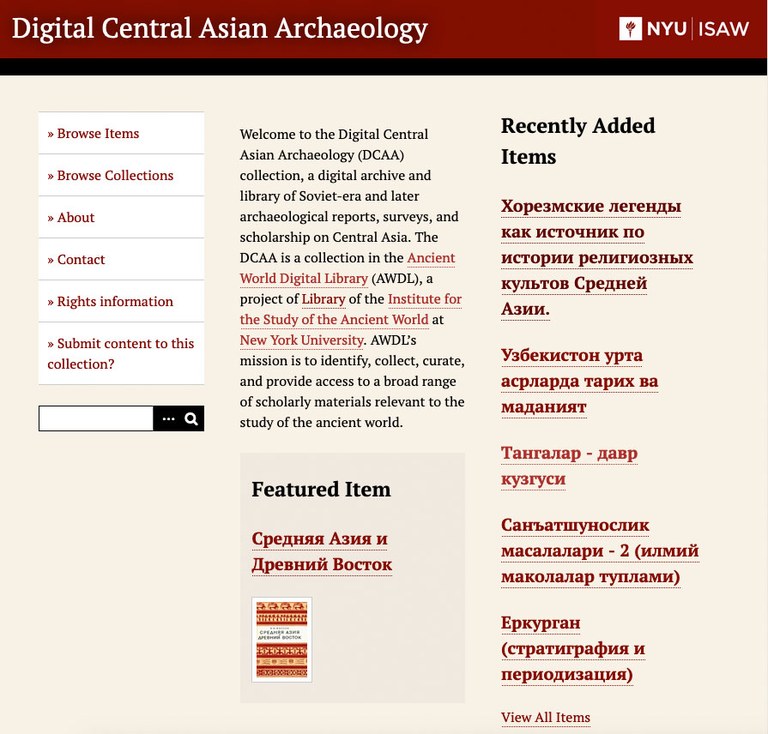Digital Central Asian Archaeology (DCAA) Collection

- Institute for the Study of the Ancient World: 977 publications
The DCAA is a collection in the Ancient World Digital Library (AWDL), an umbrella project of the ISAW Library. AWDL’s mission is to identify, collect, curate, and provide access to a broad range of scholarly materials relevant to the study of the ancient world. The DCAA originated in the pioneering work of the SilkRoDE Digital Library Project, organized by Sebastian Stride, Bernardo Rondelli, and Philipp Reichmuth (now at SIRIS Academic) between 2004 and 2005 as a joint project of the International Institute of Central Asian Studies and the Italo-Uzbek Archaeological Mission in the Middle Zerafshan Valley. In 2006-07, with funding from the Institute Français d’Études sur l’Asie Centrale (IFEAC), the Institute of Archaeology of the Uzbek Academy of Sciences (O’zRFA ATI), the UNESCO Tashkent Field Office, and several international excavation teams, the project began digitizing books, journals, and unpublished excavation notes from the collections of the O’zRFA ATI and the IFEAC. Many of these publications were scarce: some were published in editions of as few as 50 copies, and only distributed within the Soviet Union.
The resulting library contained materials of high research value, but the project lacked a means of distributing the files. An online portal to the content was created with the title Archaeological Information System of Central Asia (AISCA), but the website failed to secure ongoing funding and was taken offline. The content was distributed informally among individual scholars as a small shadow library, but the SilkRoDE team still sought an institutional partner to provide a permanent, stable home for this material.
The ISAW Library learned about this digital collection in 2015, and began devising a plan to provide an online interface and perpetual hosting for the material. The aims of the DCAA are simple: to preserve scholarly material about Central Asian history and archaeology and to make it as easily discoverable and as widely accessible as possible.
The DCAA mission was complicated by the complexities of determining and clearing copyright for Soviet publications, often from authors for whom little biographical information was available and from publishing entities that no longer exist. Copyright clearance was outside the scope of the initial SilkRoDE digitization project, which focused its efforts on digitization, and so the ISAW Library team first needed to determine what material we had the legal right to make available under US copyright law. Working with NYU’s Scholarly Communications Librarian, April Hathcock, the team devised a system for identifying public domain material, “copyright orphans,” and materials for which copyright holders could be identified and contacted. The team then worked to clear rights with authors and publishers in Russia, Uzbekistan, and other former Soviet countries, which involved designing a due diligence protocol and managing correspondence in English and Russian (for the rights-clearing process, follow this link; for more about copyright and fair use at NYU, please follow this link).
The DCAA team also developed innovative solutions for the technical challenges associated with preserving and making this material accessible online. The DCAA has been developed in such a way that discovery and access of the materials could be handled entirely within ISAW Library, while taking advantage of the digital resources available from NYU and NYU Libraries. For access and discovery, DCAA uses the free and open-source web-publishing platform Omeka, deployed using the NYU Division of Libraries’ institutional hosting service. For preservation, DCAA draws on existing institutional digital infrastructure by storing the materials in NYU’s digital repository (known as the Faculty Digital Archive), in order to create a durable online presence for the nearly 1,000 items in the DCAA. One advantage of this technical solution is that it is extensible and scalable, that is, the same basic platform and workflows can be used for similar projects involving small, focused collections in the future.